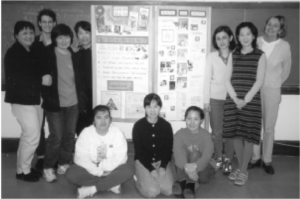HEAL Teaching: Three Experiences
by Lois Wyatt, Tom Bello, and Debra Tuler
Lois Wyatt
The HEAL:BCC curriculum opened numerous doors for our program. It opened a topic we would otherwise have avoided, even in a health unit. It provided information that mammograms and Pap tests are available regardless of one’s ability to pay. Otherwise modest, quiet students opened up. An older Muslim woman was compelled to tell the class of her own experience discovering a lump by self-exam 10 years ago. The curriculum opened an unusual intra-center sharing when two teachers arranged to visit our classes and give candid descriptions of their personal experiences with breast cancer. Both the information and the stories from the curriculum illustrated how different the shapes, discoveries, and treatments of breast cancer can be. The project opened communication among classes when our students became teachers in our culminating health fair outreach project. Organizing the fair created connections with health care personnel and resources interested in reaching our immigrant population. This well-honed curriculum package opened so many doors.
Lois Wyatt has been a teacher in the Fairfax County Public Schools Adult Education program for ten years. She has an ESL Masters Degree from George Mason University.
Tom Bello
The HEAL:BCC curriculum is learner-focused and encourages personal reactions from the students. Students should feel empowered to go into their own homes and communities to talk about the importance of good health and cancer prevention; of regular check-ups, Pap tests and early detection of any medical problems; and of proper treatment of cancer or any other diseases. As part of the curriculum, students and teachers at Willston Multicultural Center in Falls Church planned a Health Fair for the first day of spring 2001. Over 300 students attended this event and were supplied with information about insurance for low-income people, osteoporosis, heart disease, and breast and cervical cancer. Students taught students how to make necklaces with beads that were the same size as possible breast lumps. Students showed other students the health videos and translated and explained when needed.
I encourage anyone wishing to include more health instruction in the adult education/ESL curriculum to visit the rich and varied resources available to you in these materials.
Tom Bello is a full-time contract adult ESL teacher for Fairfax County Public Schools. He started teaching as a volunteer in 1979 and currently teaches the High Advanced Level at the Willston Multicultural Center in Falls Church, Virginia.
Debra Tuler
For me, the most valuable aspect of HEAL:BCC is that—in addition to its focus on learning specific health content information and developing reading, writing, listening comprehension, and speaking skills—the curriculum emphasizes problem posing, problem solving, and taking action. By taking action, I mean doing something outside the classroom, whether collecting information related to the topic, sharing information learned with others, or making changes in one’s life as a result of the information learned.
For example, in the lesson on Cancer Facts and Myths, the community follow-up activity is for students to visit clinics, doctors’ offices, or hospitals to pick up pamphlets on breast and cervical cancer. My students actually collected information on a whole range of illnesses and health issues that interested them. We reviewed these in class and created a health information folder that can be accessed by others. For many students, it was the first time they had entered a health care building in the United States. The activity offered a non-threatening way for them to go in and feel comfortable.
Another example of taking action is reflecting on our healthy and unhealthy behaviors and considering what changes we each can realistically make. One of the problem posing/ problem solving techniques we used from the curriculum is the use of codes (see sidebar). I especially like using the pictures before or instead of reading the stories, because then students have to articulate the problem rather than being given the problem.

I found that the same picture can yield many different interpretations, making for livelier discussion and reflection. In Lesson 3, Stella’s Story, my students wrote their own stories based on the pictures before we read the one provided in the curriculum. This resulted in a lot of rich material for discussion. The questions provided in the lesson about Stella’s story encouraged students to think about the obstacles they face in taking care of themselves and how they might realistically be able to change their own behaviors to lead a healthier life. I appreciated that the lesson did not provide a list of “shoulds and should nots”, but allowed students to think about what they really can and cannot do.
A final example of taking action is that a primary component of the curriculum is a group project whereby students share their learning with others. At every turn, the curriculum encourages teachers and learners to go beyond the classroom and use their learning in their communities and families, to teach others, and to take control of their own health as much as possible. In these ways, the curriculum models and demonstrates teaching/learning techniques that can be applied regardless of the content. I will be able to use many of the suggested activities (e.g. codes, cluster diagrams, community walls, and the action approach) with future classes.
Debra Tuler is the ESL Specialist and an ESL instructor with the Charlottesville Adult Education Program. She has more than 10 years experience working with adult English language learners.
What is a code?
A code is usually in the form of a written dialogue, story, or graphic. An effective code should be a familiar situation that represents the many sides of a problem , with no solution. The problem should not be overwhelming, but offer possibilities for small actions for change. The purpose of a code is to promote critical thinking and action about important issues in people’s lives.
Source: Elsa Auerbach and Nina Wallerstein. ESL for Action. Reading, MA: Addison-Wesley, 1987
